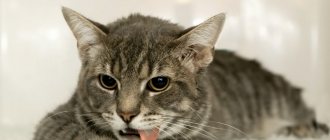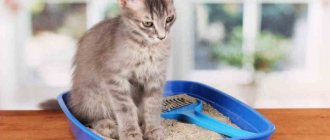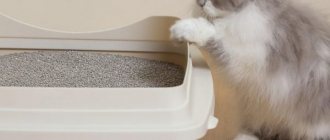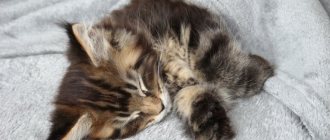Eyes are the mirror of the soul! We often say this phrase when talking about people. But, believe me, our four-legged pets also have very “talking eyes.” And since they cannot tell us about their feelings and desires in words, it is necessary to peer into these eyes more often. Remember, in them you will see love, devotion, and complete trust. They will tell you about the health status of your pet and will be able to warn you about possible problems. So, in this article we will find out why our pet’s eyes may become watery, what needs to be done in this case, and how to avoid possible diseases.
Tearfulness is a fairly common occurrence among our four-legged friends. This can be an indicator of a fairly serious disease, and sometimes it can only be the body’s reaction to debris or dust getting into the eyes. Another reason for severe tearing is dry air in the room. If it is not possible to increase the humidity, then it is necessary to instill in your pet’s eyes special moisturizers - “Artificial tears”, “Hypromellose”, “Dacrolux”. They have a lubricating and softening effect, protecting the eyes instead of tear fluid.
There are dog breeds that are prone to eye diseases, and for cats, the eyes are generally one of the most vulnerable organs.
Tears play a very important role - they cleanse and protect the eyes. They have an antibacterial effect and wash away all excess. Tear fluid is a natural protective reaction to various irritants, and therefore dogs and cats, like people, often have watery eyes, because this is the only way to moisturize their surface and get rid of any negative external factors. However, to begin with, it is worth noting that there are two main types of discharge from the eyes of an animal - mucous and purulent. To determine the disease, it is important to distinguish between them. Purulent discharge has a thicker consistency and a fairly rich greenish or yellowish tint. Oxidized tears are slightly brown or slightly reddish in color.
Causes of lacrimation in cats and dogs
Excessive tearing is not normal. This condition can be caused due to the following reasons:
- The most common reason why a cat's eyes water is due to physical discomfort. These can be foreign bodies - dust, sand, plant seeds. There may be irritating substances - smoke, chemical solutions. If a foreign body gets into the animal's eyes, the normal physiological reaction will be a copious secretion of tear fluid, which will wash the foreign body out of the eye. And once it is completely removed and there is no damage to the eye, the tearing will quickly stop. The goal has been achieved - the body has gotten rid of a foreign body that has gotten inside the eye, for example, a speck of dust or a hair.
- Another reason why a dog's eyes are very watery may be a deformation or change in the condition of the tear duct. This can occur as a result of congenital pathology of the canal, or it can also happen after mechanical injury to the eyes. The reason why a dog's eyes are watery may also be an inflammatory process. When an inflammatory process occurs (conjunctivitis), even blockage of the tear duct may occur. This provokes the release of a large amount of tear fluid. In this case, you will observe that the animal’s eyes have turned red, and the tear has become cloudy and has a yellowish or greenish tint.
- If your dog's eyes are watery or your cat's eyes are watery and purulent , the animal is most likely developing an eye infection. In this case, you need to show your cat or dog to a veterinary clinic specialist to find out why your pet’s eyes are watering , what caused the inflammatory process and how to treat it . Eye infections can cause irreversible consequences - the animal can go blind or lose its visual organs, so it is necessary to immediately begin proper therapy. And this, as you know, can only be done by an experienced veterinarian. Infections - the most common in cats - are herpesvirus infection, chlamydia, toxoplasmosis. In dogs, infectious diseases rarely manifest as inflammation of the eyes.
- Allergy. If you notice that your cat is sneezing and its eyes are watery , this is most likely due to an allergy. Take a closer look at your pet. You will probably notice how the animal tries to rub its eyes with its paw, thereby exposing them to additional injury. Remember, one of the main symptoms of an allergy is that your cat's eyes become very watery and experience constant itching in the eye area.
- Anatomical defects are most commonly seen in dogs. These include inversion and eversion of the eyelids and distichiasis (double row of eyelashes). Typically, these pathologies are specific to certain breeds of dogs, but can occur in dogs of any breed. Spitz often as a result of eyelashes and fur often growing incorrectly in their eye area, causing constant discomfort and irritation. In cats, these ophthalmological disorders are much less common than in dogs, but this can also happen. When inverted, the eyelashes are in close contact with the cornea, scratching and “cutting” it. As a result, the same inflammation and swelling develops, and the organ often becomes severely festered. When eversion occurs, the “insides” of the eyelids dry out, crack, and therefore become inflamed and swollen.
- Such a pathology as a violation of the outflow of tears, in most cases, occurs in cats. As a result of this disorder, tear fluid accumulates on the surface of the eye and overflows over the edge of the eyelid onto the muzzle. One gets the impression that the animal’s eyes seem to be running. At the same time, due to constant moisture around the eyes, a dark coloration of the fur and crust appears. Normally, tears wash the cornea and collect in the inner corner of the eye, where the tear lake is located. From the lacrimal lake, tears enter through the lacrimal puncta into the lacrimal ducts, then into the lacrimal sac, and from there along the nasolacrimal duct into the nasal and oral cavities. When there is an obstacle to the outflow of tears, lacrimation occurs. Obstacles can be observed in any part of the lacrimal drainage system, for example in the area of the lacrimal openings; possible inflammation of the lacrimal sac (dacryocystitis); compression of the tear ducts by swelling or swelling as a result of injury.
For diagnosis, a special fluorescein test is performed. To do this, a colored solution is dripped into the cat’s eyes and the time after which it appears in the nasal or oral cavity is noted. Under normal conditions, this process takes 1-5 minutes. If after 5 minutes the solution is not detected in the nose or mouth, this indicates a violation of the patency of the lacrimal ducts. Let us immediately reassure you that if your cat’s eyes are watery for this very reason, then you have nothing to worry about, and what to do with the animal after passing the test. Let us note once again that this problem is mainly of an aesthetic nature.
- Weak immunity. If the pet is too small and fell into human hands too early, the problem may be a weakened immune system. A proper diet is the key to the health of any animal, and thoughtless changes in diet can cause a cat’s eyes to start watering profusely . In this case, adjusting your diet and adding immunostimulating drugs will help. Only a veterinary clinic specialist can prescribe them. Do not prescribe the drug yourself, but seek professional help.
- Parasites in pets. The reason why a cat's eyes are watery may also be helminths. In order to avoid this, it is necessary for preventive purposes to regularly, once every 6 months, carry out antiparasitic therapy. A veterinary clinic specialist will be able to select the appropriate anthelmintic drug for your animal in the required dosage.
- A cold can also cause excessive tearing in your pet. Here the picture of the disease is very similar to an allergic reaction. If a cat is sneezing and its eyes are watery, or the animal is coughing, this is one of the clearest indicators of a cold, and you will definitely need advice from a veterinarian . Also pay attention to your pet’s appetite, how much the cat sleeps, and how much water the animal drinks. The veterinarian will ask you all this before prescribing the correct treatment.
- Eye diseases. Unfortunately, cats, like humans, suffer from eye diseases such as cataracts. You can notice this if the lens of your pet's pupil turns white. Here, of course, you also cannot do without a doctor. Treatment of this disease requires careful examination and subsequent surgical intervention.
- Tumor. Considering the constantly growing number of oncology, we should not exclude the possibility of a tumor, including a malignant one. If a cat's eye is swollen and watery , then this symptom may also indicate the growth of a neoplasm... Unfortunately, with neoplasms of malignant etiology, the cat may completely lose vision, there will be a loss of coordination, and a change in the animal's mood. You are unlikely to be able to find out about the tumor on your own, and therefore we recommend urgently seeking help from a veterinarian.
- Blepharitis. This is the scientific name for inflammation of the eyelids. With this disease, you will observe swelling of the animal’s eyelid. If you try to even lightly press an animal’s eye, you will immediately understand from the pet’s behavior that it is in pain. At the beginning of the disease and in mild cases of the disease, there will be a slightly noticeable redness on the eyelid, which may even go away spontaneously. If the cat’s immunity fails to cope on its own, the next phase of the disease will occur. The animal's eyelids will become heavy, swollen, puffy, and very hot and tense to the touch. Behavior will also change. The cat will become sedentary and inert. Most likely, she will spend most of her time lying down with her eyes closed, since even blinking in this situation causes pain to the animal, and sometimes, due to severe swelling, the eyelid simply does not open.
- Pathologies of the cardiovascular and excretory systems. This can also cause a cat's eye to water; What to do in this case - immediately undergo a full examination of your pet at a veterinary clinic. The fact is that if the functioning of the heart and kidneys is disrupted, then edema quickly develops in the body. And if we see external swelling, then most often we don’t even know about swelling of internal organs.
Eye injury
Discharge from the eye can be caused by mechanical trauma. There are countless reasons. Mostly, pets often manage to scratch their eyes with their claws, but this can also happen after a fight with other cats.
A cat can also get an eye injury if it bumps into a foreign object, such as a thorny flowerpot. Take a closer look at the animal - when injured, the cat does not rub its face with its paws, as is the case with a clogged eyelid, but simply squints.
Please note that in case of any eye injury, you should immediately show the cat to an experienced veterinarian in order to avoid deterioration of vision or blindness of your beloved pet!
How to eliminate tearing?
In order to help your pet, it is not enough just to consult a veterinarian and purchase the appropriate product. You should definitely know how to use it correctly in order to help and not harm your pet. Here is a list of simple but very effective rules:
- Wash your hands to avoid spreading dirt and infection into your pet's eyes.
- Take saline or chlorhexidine. There is no need to use tea leaves or unstrained herbal decoctions for this procedure, since a fine fraction can cause even more problems for the animal, which is important to avoid in case of conjunctivitis and other diseases. Gently use a cotton swab dipped in saline solution or warm water to clean the hair around the eyes and eyelid area. The saline solution will simply remove dirt from the eyes. But if the eyes are not only watery, but irritated and inflamed, then it is better to use chlorhexidine as a preventive measure for inflammation. This product is completely safe for your animal and will not cause any pain.
- Tilt your pet's head back and try to fix the position with one hand. Here you will need firmness and confidence in your movements, as well as a strong grip, otherwise the dog may suddenly break free and get hurt during burying. It is better, of course, to carry out this eye cleaning together, because... Not all pets like hygiene procedures. Be sure to praise your pet after the procedure and give him something tasty!
- How to wash a dog’s eyes at home if they are very watery or if a foreign object has gotten into them? Again, we suggest using chlorhexidine or vetericin. We have already talked about the benefits of chlorhexidine earlier. In this case, it is better to even use vetericin, because it relieves irritation faster and destroys more germs. Place the product in the eyes and let the dog blink. Be calm, your pet will not be hurt. Vetericin, like chlorhexidine, does not pinch or burn.
- As for humans, the ointment is placed in the conjunctival sac. To do this, the eyelid is pulled back a little, and the product is squeezed into the resulting pocket.
- My dog's eye is watering, what should I do? Be sure to use the product prescribed by your veterinarian in both eyes. This must be done not only for treatment, but also for eye prevention.
Preventive actions
- As we said earlier, special attention must be paid to the nutrition of your pet. If you are faced with the problem of severe lacrimation, first of all, analyze your pet’s menu. Just like humans, our smaller brothers should not overindulge in sweets, smoked meats, fried and fatty foods, as well as baked goods. Create a balanced menu for your pet, eliminating harmful foods and those that can cause an allergic reaction.
- When bathing an animal, be sure to ensure that detergents (shampoos, pastes, solutions) do not get into the eyes. Be especially careful when using products for fleas, ticks and other parasites.
- Do not allow the animal to be in drafts, especially immediately after washing the pet.
- Trim the long hair on the head and shorten the length of the eyelashes slightly, and also remove hair from the eye area using elastic bands and hairpins. This, of course, is more suitable for decorative breeds. The fact is that in many long-haired breeds, frequent profuse lacrimation is associated with eyelashes and fur getting into the eyes. If you are afraid to cut your dog's hair yourself, you can contact a groomer.
- Avoid contact of your pet with homeless and obviously sick animals.
- Do not neglect the constant preventive examination of your pet at the veterinary clinic.
Attention! No self-medication!
The main rule for cat owners is not to self-medicate, no matter how simple the problem may seem. Remember that any wrong action or inaction you take towards your pet can negatively affect its health.
It is always better to contact a competent specialist, for example, to the Murmansk veterinary clinic “Favorite”, where you can always get a full range of consultations, diagnosis and treatment of all cat diseases.
"Favorit" - professional care for your pet!











